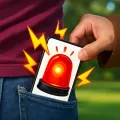Apps Home

Hidden Camera Detector
Understanding Hidden Camera Technology
Hidden cameras have evolved dramatically over the years, becoming more sophisticated and harder to detect. Initially used for espionage and intelligence operations, these devices are now readily available to the general public for various purposes, ranging from security to privacy intrusion. They can be as small as a pinhole or concealed within everyday objects like clocks, smoke detectors, or USB chargers, making detection challenging. The technology behind hidden cameras involves high-resolution lenses that can capture clear visuals even in low-light conditions. This is often coupled with infrared capabilities that allow these cameras to function at night. Furthermore, some hidden cameras are equipped with motion detection sensors, enabling them to start recording only when motion is detected, thus conserving battery life and storage space. The data captured can be transmitted wirelessly, allowing an intruder to access live footage remotely through Wi-Fi connections. Understanding the technical specifications of hidden cameras, such as the resolution, lens size, and battery life, is crucial for those seeking to protect their privacy. For instance, a camera with a higher resolution will produce clearer images, which can be more invasive. Another important aspect is the storage method; some cameras have built-in storage, while others use cloud storage solutions. This diversity in functionality poses a significant challenge to individuals who wish to ensure their privacy in spaces like bedrooms, hotel rooms, or public restrooms. Awareness of these technological intricacies forms the foundation for effectively using detection methods to secure one's privacy.
Utilizing Mobile Applications for Detecting Cameras
Mobile applications have become a revolutionary tool in the detection of hidden cameras, transforming smartphones into portable detectors. These applications typically utilize the phone's magnetometer sensor to identify unusual magnetic fields that could indicate the presence of a camera. Such an app can function by analyzing the magnetic activity around the device. If the pattern matches that of a camera, an alert is triggered. For effective use, an individual must move their mobile device close to suspicious objects where a camera might be concealed, like mirrors, air purifiers, or decorative items. The phone's sensor, often located at the top or bottom, needs to be directed towards these objects for the application to work correctly. However, it's crucial to note that not all smartphones are equipped with a magnetic sensor. For those devices, apps often offer infrared detection as an alternative method. Infrared cameras emit light at wavelengths invisible to the naked eye but detectable by most digital cameras. Thus, by using the infrared detector feature of such apps, one can scan for unexpected white light, which might reveal an infrared camera. Some apps enhance this capability by incorporating a luminescence effect, making the detection process more visual and user-friendly. However, users should be cautious as these apps might sometimes falsely detect electromagnetic interference from metallic objects as cameras. Understanding these functionalities and limitations is vital to maximize the effectiveness of detection applications in safeguarding privacy.
Best Practices for Manual Inspection and Confirmation
While technology aids significantly in detecting hidden cameras, manual inspection remains an essential component of confirmation. Relying solely on applications or electronic detectors may not always yield accurate results, especially when dealing with advanced hidden camera technologies designed to avoid detection. A manual inspection starts with a thorough visual analysis of the room or area of concern. Areas like smoke detectors, light switches, bedside lamps, or objects with lenses should receive special attention. Often, hidden cameras have small apertures to capture footage, and these can sometimes be spotted upon close examination. Employing a flashlight during the inspection can be highly effective, as it can reveal camera lenses by reflecting light off the miniature lenses. In addition to visual checks, users can perform practical tests such as switching off the lights to scan for infrared-based surveillance, as these devices emit faint lights not visible under normal conditions. Moreover, physical examination by touching suspicious objects can sometimes reveal unusual wiring or components. Another practical approach is to question and research anomalies—if something looks out of place or unnecessarily technological, investigate it further. Since camera technology often incorporates recording or transmitting features, inspecting for unusual Wi-Fi networks or Bluetooth signals can also provide clues to hidden cameras. Ultimately, a combination of technological tools and manual inspection ensures a more comprehensive approach to identifying potential surveillance threats in one's environment.
The Role of Privacy Laws and Personal Rights
Understanding the legal landscape surrounding hidden cameras is crucial for empowering individuals to protect their privacy rights. Different jurisdictions have varying laws regarding the use of surveillance devices, and being aware of these can significantly impact how one addresses potential privacy intrusions. Generally, it is illegal to install hidden cameras in private spaces without consent. This includes bathrooms, dressing rooms, and bedrooms. However, the laws become complex in public spaces or when recordings are made by owners for security purposes. In many places, workplaces and landlords are permitted to use surveillance cameras for security reasons, but they must notify their tenants or employees and ensure cameras are not placed in areas where there is an expectation of privacy. The ramifications of breaching these regulations can be severe, involving both criminal charges and civil lawsuits. For victims of unlawful surveillance, understanding these legal avenues is essential for seeking justice and compensation. Privacy organizations and advocacy groups often provide resources and assistance for people looking to educate themselves about their rights. Furthermore, with the advent of smart home devices and IoT, the line between lawful surveillance and privacy invasion is continuously blurred, necessitating ongoing education and awareness. By staying informed about these laws and advocating for stricter regulations, individuals not only protect themselves but also contribute to a broader societal awareness of privacy rights in the digital age.
Practical Steps to Enhance Personal Privacy
Taking practical steps to enhance personal privacy involves a proactive approach that combines technology, awareness, and behavioral change. Initially, familiarize yourself with the spaces you inhabit frequently, be it your home, office, or travel lodgings. Regularly performing thorough checks using hidden camera detectors, such as those available in app form, helps identify suspicious devices. However, beyond detection, it's important to implement strategies that can deter unauthorized surveillance. Adding decorative elements like plants or picture frames that obscure potential camera locations can serve as a preventive measure. Additionally, utilizing privacy-preserving devices such as camera covers or filters that block lenses in sensitive areas without hindering functionality is another effective tactic. In environments where surveillance might be a concern, adopt the habit of minimal sharing of private information or activities. Furthermore, consider upgrading to smart devices with enhanced privacy controls, allowing better regulation of data shared with third parties. For frequent travelers, choosing accommodation facilities with reliable reviews focusing on customer privacy rights can also be beneficial. Finally, educating oneself and staying updated about the latest surveillance technology is vital; the more informed you are, the better your ability to protect your privacy. Engaging with online communities or attending workshops focused on privacy and security can provide valuable insights and support. For those interested in further enhancing their measures, Download for Android and explore additional safety features at your disposal.
Share Your Opinion
Your Email Will Not Be Published.
All Rights Reserved © Apps Home 2025


































A Google user
I personally thought i was going crazy. We live in a motel unit. Manager said something, that only my husband and I should have known. I used this ...
AKASHDEEP SINGH INSAN
Really useful and it works properly. I found many camers and it viberates when camera is near to you. It has different modes to detect different ca...
A Google user
Went gold for my own purposes. Has exceeded my expectations so far. Raw X, Y, Z data invaluable as I document any incident and anomaly. The green l...
William Noland
The magnetic meter works the best of the two in app sensors. Well accurate to within 6 inches or less consistently. The IR detector works best if y...
Bobby Winningham
Some features won't work on this "Verizon Total."....my new b160V, doesn't come with a built in censor, (magnetic),..but, any of the previous smart...